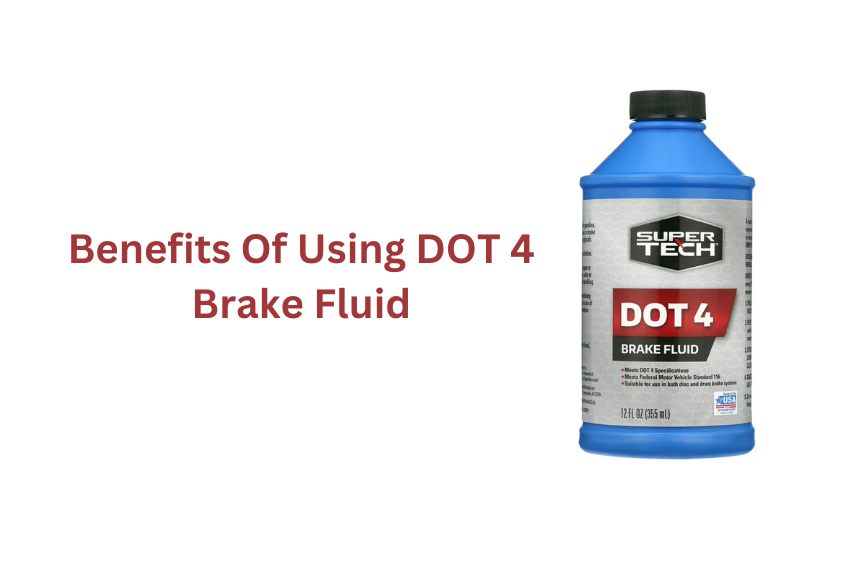Are you looking to enhance your vehicle’s braking performance?
DOT 4 brake fluid has lots of important advantages over lower-grade options.
In this guide, you’ll learn about the benefits of using DOT 4 and how it can improve your driving experience.
What Are The Benefits Of Using DOT 4 Brake Fluid?
DOT 4 brake fluid offers many key advantages over lower-grade fluids like DOT 3, which has made it a popular choice for many vehicle owners.
Higher Boiling Point:
One of the most significant benefits of DOT 4 is its higher boiling point.
While DOT 3 has a boiling point of around 230 degrees Celsius (446 degrees Fahrenheit), DOT 4 can reach boiling points as high as 260 degrees Celsius (500 degrees Fahrenheit).
This higher boiling point means it’s less likely to vaporize under extreme conditions, such as heavy braking or high temperatures.
When brake fluid vaporizes, it can create air pockets in the braking system, leading to reduced braking power and a condition known as “brake fade.”
DOT 4’s higher boiling point helps prevent brake fade, providing consistent stopping power and improving overall vehicle safety.
Improved Braking Performance:
Thanks to its superior properties, DOT 4 can provide improved braking performance compared to DOT 3.
It offers quicker response times and can help reduce stopping distances, especially in demanding driving situations.
This can be particularly beneficial for high-performance vehicles or those driven in areas with hilly terrain.
Enhanced Resistance To Fading:
As mentioned earlier, DOT 4’s higher boiling point helps prevent brake fade.
This is mostly important during extended periods of heavy braking, such as on long downhill slopes or in stop-and-go traffic.
By resisting fading, DOT 4 ensures that your brakes remain effective even under demanding conditions.
Better Compatibility:
DOT 4 is generally compatible with a wider range of vehicle types compared to DOT 3.
It can be used in both older and newer vehicles, as well as in high-performance cars, SUVs, and trucks. Its versatility makes it a popular choice for many drivers.
Longer Service Life:
DOT 4 is designed to have a longer service life than DOT 3.
It is less prone to degradation over time, meaning it can maintain its performance for a longer period, which can help reduce maintenance costs and ensure that your braking system remains reliable.
Is DOT 4 Brake Fluid Compatible With All Vehicles?
DOT 4 brake fluid is generally compatible with a wide range of vehicles, including modern cars, SUVs, trucks, and even some classic cars.
However, there are specific exceptions, and it’s always recommended to consult your vehicle’s owner’s manual for accurate information.
The owner’s manual contains specific recommendations for the type of brake fluid to use in your vehicle.
This information is essential because some manufacturers may have unique requirements or limitations regarding brake fluid compatibility.
Always refer to the manual for the most accurate and up-to-date guidance.
While DOT 4 is often compatible, there may be certain vehicle models or manufacturers that have specific requirements or limitations.
For example, some older vehicles or those with unique brake systems may require a different type of brake fluid.
And, a common question is whether DOT 3 and DOT 4 brake fluids can be mixed.
While it’s generally not recommended to mix different types of brake fluids, there may be rare cases where it’s possible.
However, it’s best to consult the owner’s manual or a qualified mechanic for specific guidance.
Mixing brake fluids can potentially lead to compatibility issues or performance problems.
With that said, while DOT 4 is generally compatible with many classic cars, you need to consider the age and specific characteristics of your vehicle.
Older vehicles may have different brake systems or require a specific type of brake fluid.
How Does DOT 4 Brake Fluid Compare To Other High-Performance Brake Fluids?
DOT 4 is a popular choice for high-performance vehicles, but how does it compare to other options like DOT 5.1?
| Property | DOT 4 | DOT 5.1 |
| Boiling Point | Higher (typically around 260°C or 500°F) | Lower (typically around 260°C or 500°F) |
| Viscosity | Medium | Low |
| Compatibility | Compatible with a wider range of vehicles, including older cars, SUVs, and trucks | Primarily used in racing applications and may have more specific compatibility requirements |
| Moisture Absorption | Absorbs moisture from the environment | Less susceptible to moisture absorption |
| Typical Applications | Daily driving, high-performance vehicles, SUVs, trucks | Racing, high-temperature environments, where resistance to moisture is crucial |
| Advantages | Versatile, suitable for a wide range of vehicles, higher boiling point for improved braking performance | Lower viscosity for better braking response time, resistant to moisture |
| Disadvantages | May be more susceptible to moisture absorption | Limited compatibility, lower boiling point |
